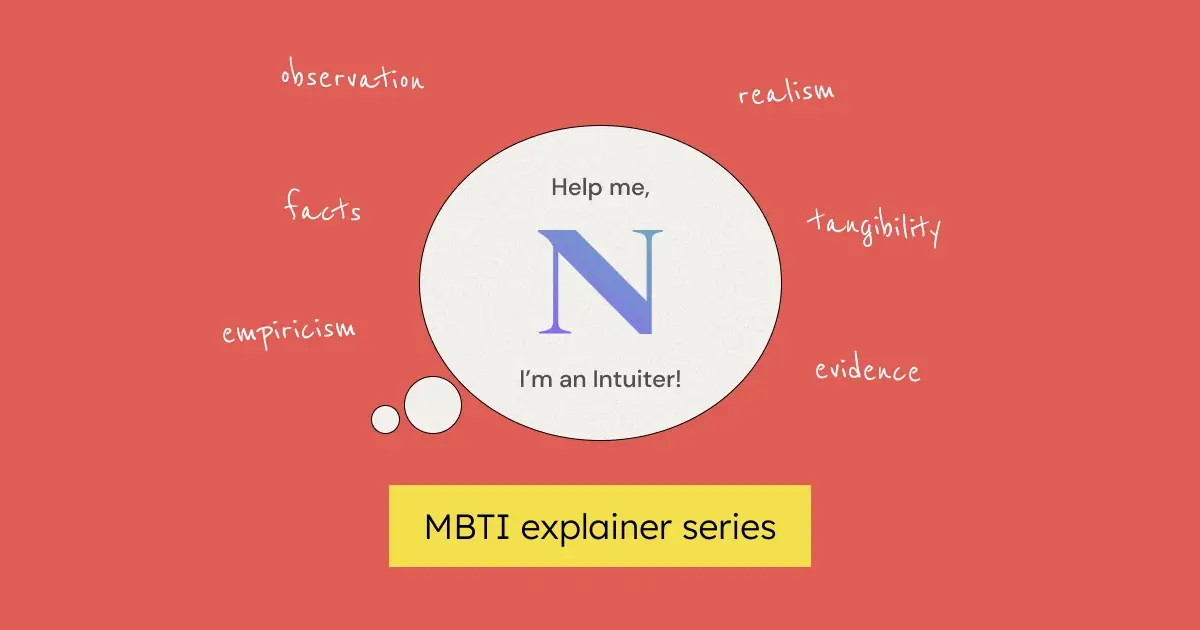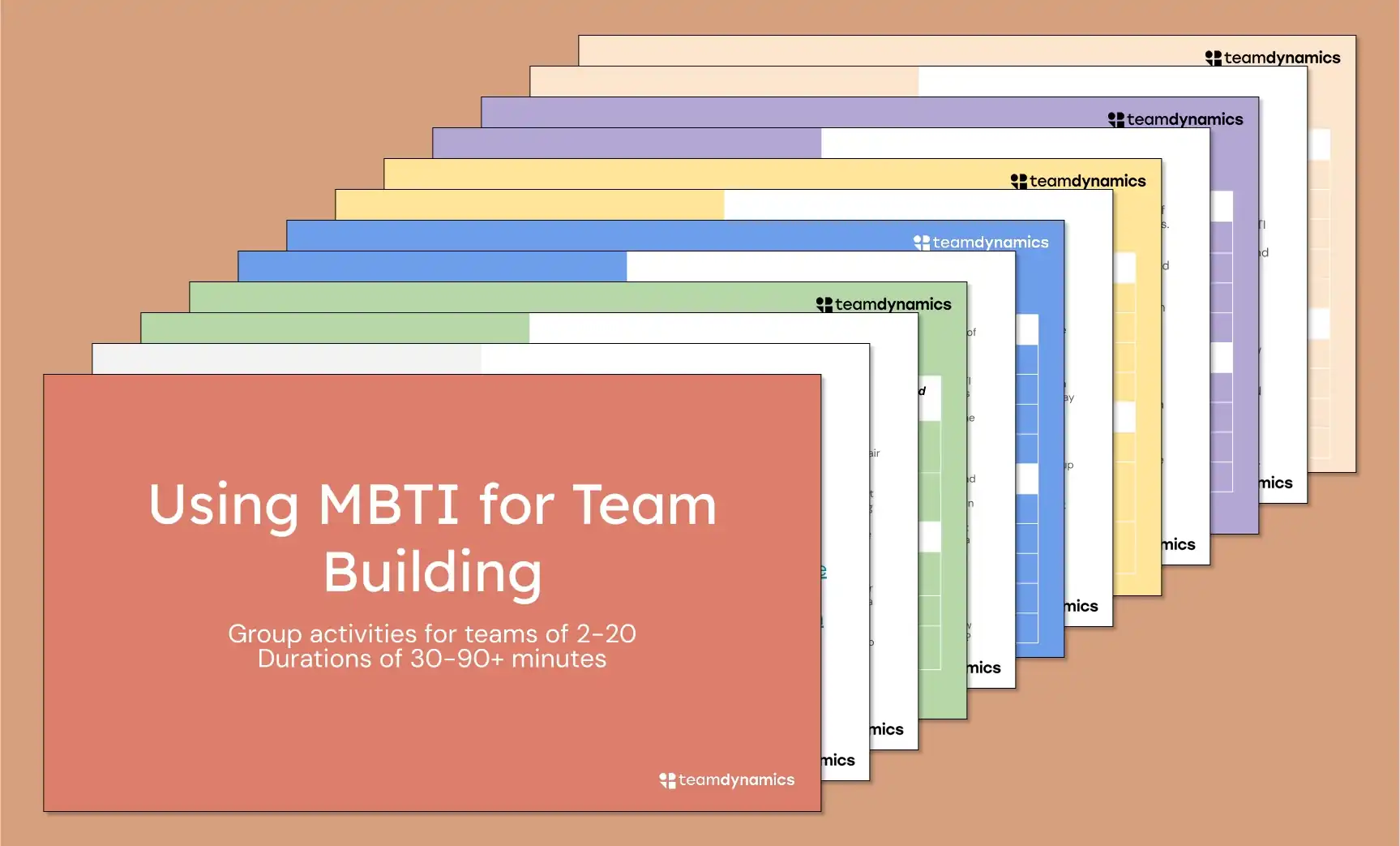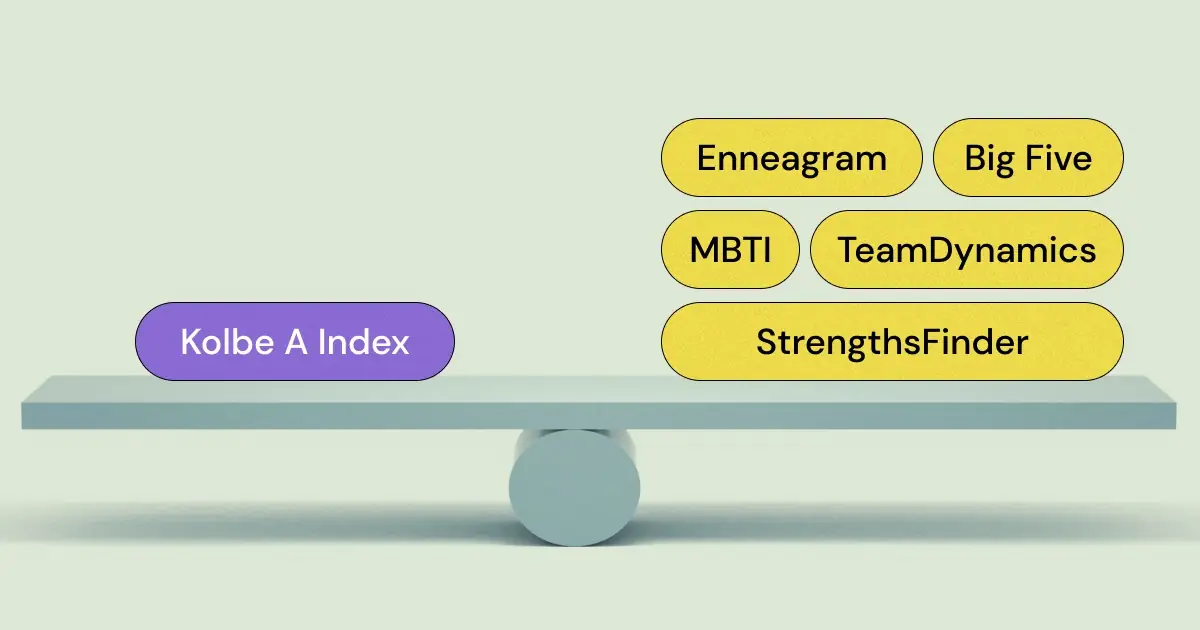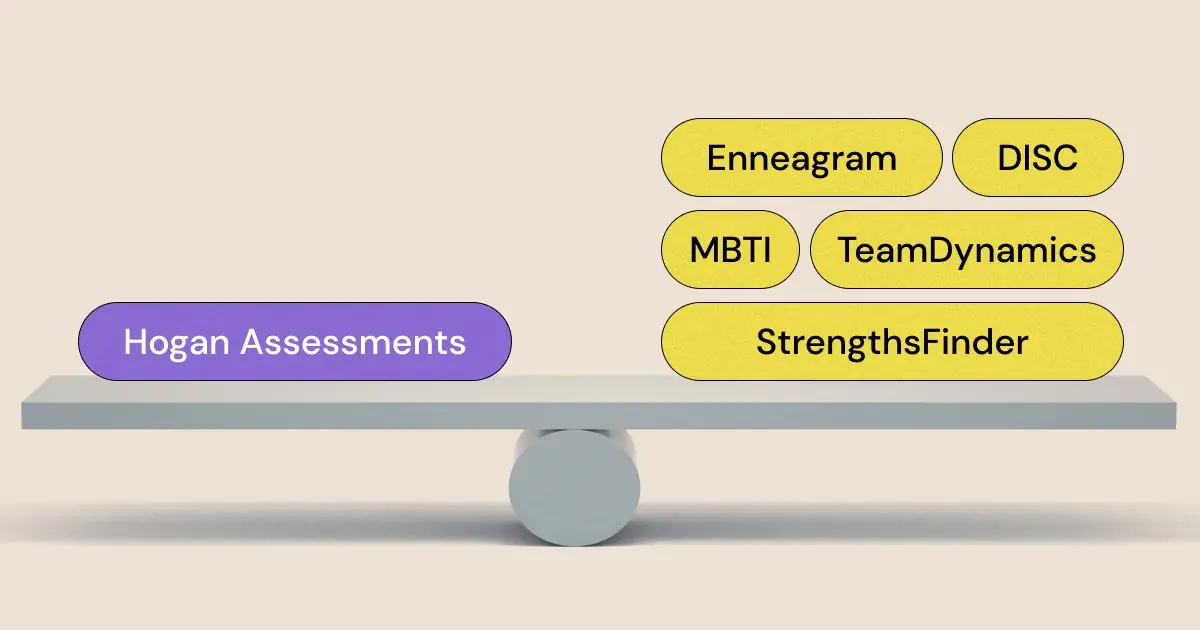If you're here, it's likely because you've taken the Myers-Briggs Type Indicator (MBTI) test and discovered you're an 'Intuiting' type. You may find that working with teammates who are 'Sensing' types can sometimes be challenging. But don't worry! Our goal in this blog post is to help bridge that gap and improve your team collaboration.
So what is this MBTI thing we're talking about? The Myers-Briggs Type Indicator is a personality test that helps identify different ways people see the world and make decisions. It splits personality traits into pairs, and one of these pairs is 'Intuiting' and 'Sensing'.
Here's a simple way to understand it: Imagine you're in a forest. If you're an 'Intuiting' type, you're more likely to see the forest as a whole - the big picture. You'd think about the type of trees, why they might grow there, and what that means for the ecosystem. If you're a 'Sensing' type, on the other hand, you would focus more on the individual trees - the details. You'd notice the bark's texture, the leaf shape, and the sounds around you.
Both perspectives are important. The 'Intuiting' person helps guide the overall direction, and the 'Sensing' person makes sure no detail is missed along the way. However, these different approaches can sometimes cause misunderstandings in a team setting.
Looking to use MBTI for team building? Download these free templates for MBTI team building workshops!
By reading this blog, you'll learn effective communication strategies, understand workplace dynamics better, and ultimately increase your team productivity. Stay with us as we journey through understanding these two personality types and how they can work together harmoniously in a team setting.
Understanding the 'Intuiting' Type
Let's dive deeper into what it means to be an 'Intuiting' type according to the Myers-Briggs Type Indicator (MBTI). If you identify as this type, you're in good company!
Being an 'Intuiting' type means you're someone who tends to focus on the big picture. You grasp patterns and possibilities as you aim to understand concepts and theories. Rather than sticking to only what's right in front of you, you prefer thinking about future possibilities. You're fascinated by innovation and you're often the one to think 'outside the box'.
Let's consider an example. Meet Alex, an 'Intuiting' type who works in a tech startup. While his colleagues are discussing the details of their current project, Alex is already thinking about the next innovative feature they could implement. He often shares new ideas during meetings, suggesting improvements that could benefit the product in the future. While his foresight is a strength, sometimes his teammates feel he's not fully present because he's always thinking about what's next.
{{inline-cta}}
The 'Intuiting' characteristic, like Alex's, is vital in the workplace. It encourages progress, stimulates creativity, and drives innovation. However, it can sometimes clash with 'Sensing' types, who place more focus on the concrete details of the here and now.
In the following sections, we'll dive into understanding the 'Sensing' type and explore effective communication strategies to enhance team collaboration, workplace dynamics, and overall team productivity. Stay tuned as we navigate this journey of 'Intuiting and Sensing' together!
Understanding the 'Sensing' Type
Now that we have an idea about the 'Intuiting' type from the Myers-Briggs Type Indicator (MBTI), let's explore the 'Sensing' type. While 'Intuiting' types like Alex from our previous example are big-picture thinkers, 'Sensing' types are the detail-oriented individuals in the team.
If you're a 'Sensing' type, you value the information you can gather through your five senses. You're practical, detail-oriented, and focused on the present. Instead of abstract concepts or future possibilities, you're more concerned with the facts and realities that can be proven right here and right now.
Meet Maria, a 'Sensing' type who works alongside Alex in the same tech startup. Maria is the person who ensures that Alex's big ideas can actually come to life. When Alex presents a new idea, Maria asks the practical questions: "Do we have the resources for this?" "What's the timeline?" "How will this fit into our current project?" She pays attention to the details and keeps everyone grounded.
Maria's strength lies in her ability to deal with concrete facts and tangible elements. This is crucial to any team's productivity, ensuring that ideas don't remain as just ideas but are transformed into actionable tasks.
However, this practical and detail-oriented approach of 'Sensing' types can sometimes clash with the big-picture, future-oriented thinking of 'Intuiting' types. In our upcoming sections, we'll look at these challenges and provide effective communication strategies that can help improve team collaboration and enhance workplace dynamics between 'Intuiting and Sensing' types. So, stay with us as we continue this fascinating journey of personality types at work!
The Challenges 'Intuiting' Individuals Face when Working with 'Sensing' Individuals
Although both 'Intuiting' and 'Sensing' types bring unique strengths to a team, they can also encounter challenges when working together due to their different approaches to problem-solving and decision-making. Let's delve into some common issues that 'Intuiting' types, like our friend Alex, may encounter when working with 'Sensing' types, like Maria.
Firstly, 'Intuiting' types may sometimes find it frustrating that 'Sensing' types focus on the details and practicalities. They might feel their innovative ideas are being quashed too soon, without giving them a chance to fully explore the possibilities.
Take a regular team meeting, for example. Alex excitedly presents an idea for a new feature in their app that could revolutionize the user experience. However, Maria immediately asks about the feasibility, resources, and timeline. Alex might feel that Maria is being too narrow-minded and not seeing the potential benefits his idea could bring.
On the flip side, 'Sensing' types might find 'Intuiting' types too vague or abstract. They may feel that the 'Intuiting' individuals aren't taking into account the realities of the present situation.
Another example: during a project planning session, Maria presents a well-researched plan based on current data and practical considerations. Alex, however, argues for a different approach based on a new trend he believes will become important. Maria might feel that Alex is ignoring the hard data in favor of unproven theories.
These challenges can lead to miscommunication and misunderstandings, affecting both workplace dynamics and team productivity. But don't worry - recognizing these challenges is the first step to overcoming them. In our next section, we'll look at effective communication strategies that can help 'Intuiting' and 'Sensing' types work together more efficiently and harmoniously. So, keep reading as we continue to explore the world of 'Intuiting and Sensing' in the workplace!
The Challenges 'Intuiting' Individuals Face when Working with 'Sensing' Individuals
Although both 'Intuiting' and 'Sensing' types bring unique strengths to a team, they can also encounter challenges when working together due to their different approaches to problem-solving and decision-making. Let's delve into some common issues that 'Intuiting' types, like our friend Alex, may encounter when working with 'Sensing' types, like Maria.
Firstly, 'Intuiting' types may sometimes find it frustrating that 'Sensing' types focus on the details and practicalities. They might feel their innovative ideas are being quashed too soon, without giving them a chance to fully explore the possibilities.
{{inline-cta}}
Take a regular team meeting, for example. Alex excitedly presents an idea for a new feature in their app that could revolutionize the user experience. However, Maria immediately asks about the feasibility, resources, and timeline. Alex might feel that Maria is being too narrow-minded and not seeing the potential benefits his idea could bring.
On the flip side, 'Sensing' types might find 'Intuiting' types too vague or abstract. They may feel that the 'Intuiting' individuals aren't taking into account the realities of the present situation.
Another example: during a project planning session, Maria presents a well-researched plan based on current data and practical considerations. Alex, however, argues for a different approach based on a new trend he believes will become important. Maria might feel that Alex is ignoring the hard data in favor of unproven theories.
These challenges can lead to miscommunication and misunderstandings, affecting both workplace dynamics and team productivity. But don't worry - recognizing these challenges is the first step to overcoming them. In our next section, we'll look at effective communication strategies that can help 'Intuiting' and 'Sensing' types work together more efficiently and harmoniously. So, keep reading as we continue to explore the world of 'Intuiting and Sensing' in the workplace!
Effective Communication Strategies for 'Intuiting' Individuals
Communication is key in any team, but when 'Intuiting' and 'Sensing' types are working together, it becomes even more critical. As an 'Intuiting' type, your communication approach can make a huge difference in team collaboration and overall workplace dynamics.
One important strategy is using clear and precise language. Remember, your 'Sensing' teammates, like Maria, tend to focus on concrete details and facts. They may not instantly connect with abstract ideas or theories, so it's crucial to express your thoughts in a way they can easily grasp.
Let's go back to our friend Alex. Instead of saying, "I think we should focus more on virtual reality features in our app because it's the future," he could say, "According to the data from tech industry reports, virtual reality features in apps are projected to see a 20% growth in the next two years. If we start developing these features now, we could potentially increase our user engagement and stay ahead of the competition." This way, Alex communicates his forward-thinking ideas, but grounds them in concrete details that Maria and other 'Sensing' types can appreciate.
Another strategy is to give your 'Sensing' colleagues time to process new ideas. Instead of expecting immediate feedback in a meeting, you could share your ideas in advance. This gives them time to consider the details and practicalities before discussing it further.
Lastly, value their focus on details. When 'Sensing' types ask practical questions about your ideas, they're not trying to shoot them down. They're making sure your team can successfully execute these ideas. So, be patient, respond to their queries, and together you'll develop a robust plan that marries innovation with feasibility.
In our next section, we'll discuss how 'Intuiting' individuals can appreciate and utilize the strengths of 'Sensing' colleagues, enhancing both team collaboration and productivity. So, continue with us on this journey into the world of 'Intuiting and Sensing' in the workplace!
How 'Intuiting' Individuals can Appreciate 'Sensing' Colleague's Strengths
As we've discussed in our journey into the world of 'Intuiting and Sensing' in the workplace, 'Sensing' types like Maria bring a host of strengths to the team. As an 'Intuiting' type, recognizing and appreciating these can significantly enhance team collaboration and productivity.
'Sensing' types are detail-oriented and practical. They excel in tasks that require precision, focus, and a careful approach. Their knack for dealing with facts and realities makes them invaluable when it comes to planning, executing, and troubleshooting tasks. They can provide balance to your big-picture thinking, ensuring that ideas are feasible and grounded in the current situation.
Consider this: Alex has an idea for a new app feature that he believes could boost user engagement. Instead of feeling frustrated when Maria asks about the practicalities, Alex can see it as an opportunity. Maria's questions help Alex refine his idea, ensuring it is not only innovative but also achievable.
Moreover, 'Sensing' types are often great at remembering specifics and learning from past experiences. This ability can be incredibly beneficial when evaluating past projects or making decisions based on historical data.
For instance, during a project review, Maria might remember a similar idea that was implemented a year ago and had some issues. She can provide specific insights that help the team avoid past mistakes and improve upon previous efforts. Alex can appreciate this input as it contributes to making his innovative ideas even better.
In summary, 'Sensing' types have a plethora of strengths that can complement 'Intuiting' types wonderfully. It's all about understanding, appreciating, and effectively communicating with each other. By doing so, you can create a vibrant workplace dynamic that boosts team productivity.
Stay tuned for our next section, where we'll provide additional tips for 'Intuiting' types working with 'Sensing' types, further enhancing your team collaboration journey with the Myers-Briggs Type Indicator (MBTI). Keep learning, keep growing!
Techniques for 'Intuiting' Types to Adapt to a 'Sensing'-dominated Team
In a 'Sensing'-dominated team, 'Intuiting' types might need to adjust their approach slightly to collaborate effectively and enhance workplace dynamics. Here are some techniques that can help you, as an 'Intuiting' type, navigate a team largely composed of 'Sensing' individuals like Maria.
1. Be Detailed and Concrete
Try to include more facts and specific details when presenting your ideas. Instead of saying, "This feature will make our app more user-friendly," say, "This feature will reduce the number of steps a user has to take to make a purchase, thereby enhancing the user experience."
2. Value Practicality
Before presenting an idea, consider its practical aspects. What resources will it require? What's the timeline? How does it fit with current projects? This approach aligns with 'Sensing' types' focus on the here and now, and it can make your ideas more appealing to them.
3. Learn From the Past
'Sensing' types often use past experiences to inform their decisions. While your strength lies in looking towards future possibilities, try to incorporate lessons from previous projects to make your suggestions more grounded and appealing to your 'Sensing' colleagues.
4. Patience and Respect
Finally, remember that each personality type brings unique strengths to the team. Be patient with 'Sensing' types' need for details and practicalities. Show them respect and acknowledge the value they add to the team, just as they should appreciate your visionary and innovative approach.
For example, in a project meeting, Alex could say, "Maria, your ability to consider all the practical details is crucial for us. I have this idea, and I'd appreciate your input on how we can make it work within our current resources."
By implementing these techniques, you can ensure that your team benefits from the best of both 'Intuiting and Sensing' approaches. The blend of big-picture thinking with practical execution can significantly enhance team productivity and lead to better results.
Case Study: Successful 'Intuiting' and 'Sensing' Collaboration
To truly appreciate the power of 'Intuiting and Sensing' collaboration, let's dive into a real-world case study that showcases how these two personality types can harmonize to drive team productivity and success.
Meet James and Lucy. James, an 'Intuiting' type, works as a product manager in a tech start-up, while Lucy, a 'Sensing' type, is the lead developer. They recently collaborated on a project to revamp their company's mobile application.
James came up with an innovative idea for a new feature, inspired by upcoming trends and his vision of how technology would evolve. However, he was struggling to convince Lucy and her team of developers, who were skeptical about the feasibility of his concept.
Recognizing the potential communication gap between their 'Intuiting' and 'Sensing' approaches, James changed his tactic. He started presenting his ideas with more concrete data and practical implementation plans, thereby speaking Lucy's language. He also took the time to understand the constraints and challenges from Lucy's point of view.
{{inline-cta}}
Lucy, on the other hand, appreciated James' effort and started to see the potential in his innovative ideas. She used her strength in focusing on the details and practical aspects to help shape James' ideas into a more feasible plan. She also provided feedback from past projects that helped avoid potential pitfalls in the development process.
In the end, not only was the project a great success, but it also led to a significant increase in user engagement, just as James had envisioned. This was a big win for the start-up, thanks largely to the effective 'Intuiting and Sensing' collaboration between James and Lucy.
The key factors contributing to their success were understanding and appreciating each other's strengths, effective communication strategies, and a willingness to adapt their approach for the benefit of the team. This case study beautifully illustrates how 'Intuiting' and 'Sensing' types, when working in harmony, can leverage their distinct strengths to achieve common goals.
In the next section, we'll wrap up our deep dive into 'Intuiting and Sensing' collaboration in the workplace. Keep reading to find out how the lessons learned from James and Lucy's experience can be applied to your own team dynamics. Stay tuned!
Conclusion
We've embarked on an enlightening journey to explore the dynamic between 'Intuiting' and 'Sensing' individuals in the workplace through the lens of the Myers-Briggs Type Indicator (MBTI). By now, it's clear that both 'Intuiting' and 'Sensing' types bring unique strengths to the table. Whether you're an 'Intuiting' type navigating a 'Sensing'-dominated team or vice versa, the key to team productivity lies in understanding, appreciating, and leveraging these differences.
As an 'Intuiting' individual, you're a visionary, always looking at the big picture and future possibilities. Your 'Sensing' colleagues, like Lucy in our case study, have a keen eye for detail, practicality, and learn from past experiences. When these forces combine, you can create a powerful, balanced team that's capable of both innovative ideas and their efficient execution.
Remember the effective communication strategies we've discussed. Be clear and detailed with your ideas, consider practical aspects, and learn from the past. These techniques will help bridge the gap between 'Intuiting' and 'Sensing' types, as demonstrated by James and Lucy's successful collaboration.
Moving forward, we encourage you to look at your 'Sensing' teammates as invaluable assets to your team. They complement your strengths and can help turn your visionary ideas into tangible results. With patience, understanding, and effective communication, you can foster an environment of team collaboration and boost workplace dynamics.
Finally, don't forget to apply the suggestions from this blog in your everyday interactions at work. It's not just about learning these concepts but about putting them into practice. The real magic happens when you start seeing the improvements in your team's performance and dynamics.
Keep exploring, keep learning, and here's to more collaborative, dynamic, and productive teams!
Check out our other MBTI resources!
We hope you've found this guide useful. Remember, everyone's experience is unique, and it's about finding strategies that work best for you. If you enjoyed reading this, don't keep it to yourself! Share it with your friends, colleagues, or anyone you think could benefit from it. Let's create a more understanding and inclusive workplace together!
MBTI is one of the most popular personality tests, and people are always asking us how they can better use it with their teams. Here are a few other useful articles you can try:
And if you're looking to crack the code on working with a specific MBTI type, check out our guides written just for you:
Interested in diving deeper into personality types, teamwork, and team performance? We've got a treasure trove of insightful articles just waiting for you to explore. Check out our other blogs on topics like team dynamics, effective communication strategies, and more in-depth dives into different personality tests. And check back often - we're always publishing more great content!




.png)









































